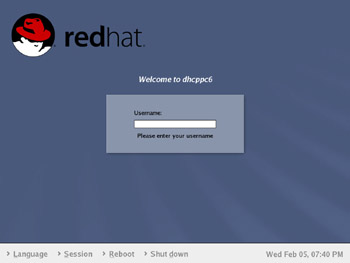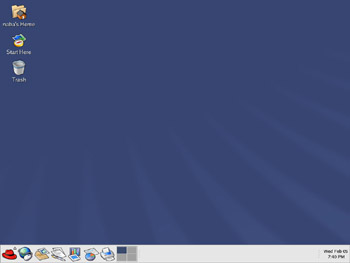Starting Red Hat Linux for the First Time
Starting Red Hat Linux for the First Time
After the installation is complete, the Red Hat Linux installation program automatically reboots the system. The PC goes through its normal power-up sequence and loads the boot loader-GRUB or LILO, depending on which one you selected when you installed Red Hat Linux. A graphical screen appears with the names of the partitions the boot loader can boot. You can press the up and down arrow keys to select the partition from which the system should boot. When you installed the boot loader, if you specified the Linux partition as the default one, you can simply wait; after a few seconds, Red Hat Linux starts.
Controlling Linux with Boot Parameters
Before you select a partition to boot, you can get a text-mode prompt from the bootloader and enter other commands. If you use LILO as the boot loader, press Ctrl-X and you get the following prompt:
LILO boot:
You can view the names of the available bootable partitions by pressing the Tab key. For example, a typical result of pressing Tab might be the following:
linux windows
Then, you can type the name of the partition from which LILO should boot.
After Linux starts, you should see a long list of opening messages, including the names of the devices that Linux detects. One of the messages says Calibrating delay loop... xxx.xx BogoMIPS, where xxx.xx is some number. BogoMIPS is one of those words that confound new Linux users.
| Insider Insight |
As you may know, MIPS is an acronym for millions of instructions per second-a measure of how fast your computer runs programs. As such, MIPS is not a very good measure of performance because comparing the MIPS of different types of computers is difficult. BogoMIPS is bogus MIPS, which refers to an indication of the computer's speed. Linux uses the BogoMIPS number to calibrate a delay loop, in which the computer processes some instructions repeatedly until a specified amount of time has passed. The BogoMIPS numbers can range anywhere from 1 to 3,000 or more, depending on the type of processor (386, 486, or Pentium). An older 33MHz 80386DX system has a BogoMIPS of about 6, whereas a 66MHz 80486DX2/66 system shows a BogoMIPS of about 33. The BogoMIPS for newer Pentium systems is much higher. For example, on an old 200MHz Pentium MMX system, Linux reports a BogoMIPS of 398.13. However, on a laptop with a 1.5GHz Celeron processor, the BogoMIPS is 2,971.18. It's higher yet on more recent 3GHz or better Pentium 4 systems. |
Configuring for the First Time with Firstboot
If you are booting Red Hat Linux for the first time after installation, a server named firstboot runs and displays a welcome screen about setting up Red Hat Linux. The firstboot server (Red Hat calls it the Red Hat Setup Agent) takes you through date and time setup, gives you a chance to register with Red Hat Network, and install any additional CDs.
| Caution |
If the screen goes dark and there is no activity, the first-time configuration utility may be having trouble starting the X Window System. Unfortunately, you cannot proceed any further without fixing this problem. Sometimes the graphical environment fails even though the graphical interface seems to work fine during installation. There are ways to fix this problem. Go to Chapter 2 for more information on how to troubleshoot this problem. |
The Red Hat Setup Agent takes you through the following steps (you can skip these steps if you want)
-
Set the date and time from a GUI screen. If your system is connected to the Internet, click the check box labeled Enable Network Time Protocol and then select a server from the drop-down list labeled Server. This way, the system is going to get its time directly from one of the superaccurate time servers on the Internet using the Network Time Protocol (NTP). After setting the date and time, click Forward.
-
The Red Hat Setup Agent then prompts you if you want to register with Red Hat Network. To register, click Forward and respond to the requested information. After that step is done, click Forward again.
-
The Red Hat Setup Agent displays a window from which you can install additional CDs. If you have additional CDs to install, click the appropriate icon. Otherwise, click Forward.
Logging in at Graphical Login Screen
On first-time boot, you get the graphical login screen after you're through with the Red Hat Setup Agent. At other times, you would first see the boot messages, and at the end of all the messages, if all goes well, you get a graphical login screen, such as the one shown in Figure 7-1.

Figure 7-1: Graphical Login Screen in Red Hat Linux.
You can log in using any of the accounts you define during the installation, including root. For example, to log in as root, type root in the first text field, and press Enter (move the mouse over the login dialog box before you begin typing). Then, type the root password (the one you set during installation) to log in as the super user.
Because the default GUI is GNOME, the GNOME desktop appears, as shown in Figure 7-2. As you can see, the desktop is similar to the Windows desktop. Now, you can perform a few initial chores and learn how to shut down your Red Hat Linux system.

Figure 7-2: Initial GNOME Desktop.
Take a moment to look at the initial GNOME desktop as it appears in Figure 7-2. The GNOME desktop is very much like the Windows desktop. The GNOME Panel-similar to the Windows taskbar-appears along the bottom edge of the screen.You can access various menus and launch applications from the GNOME Panel. The Panel also contains such applets as the Clock, which displays the time in a small area at the right edge of the Panel.
| Cross Ref |
You learn more about the GNOME desktop in Chapter 9. For now, all you need to know is that the red hat icon at the left edge of the GNOME Panel is the Main Menu button. This button is like the Start button in Microsoft Windows. You can access many programs from the Main Menu button (the red hat icon). You can also start some programs by clicking the icons on the Panel. For example, to start the Mozilla Web browser, click the earth-and-mouse icon on the Panel. |
The following sections show you how to log out of and shut down your Red Hat Linux system.
Logging Out
Now that you have seen how to log in, you should learn how to log out. To log out, select Main Menu (the red hat icon)>Log Out. The screen is grayed out, and a dialog box asks you if you really want to log out. Click the OK button to log out.
| Cross Ref |
After a few moments, the graphical login screen (refer to Figure 7-1) appears again so that another user can log in and use the system. The graphical login window is displayed by a display manager such as xdm (X Display Manager), gdm (GNOME Display Manager), or kdm (KDE Display Manager). You learn more about the display managers and configuration of the graphical logins in Chapter 9. |
Shutting Down Linux
When you are ready to shut down Red Hat Linux, you should do so in an orderly manner. Even if you are the sole user of a Linux system, several other programs are usually running in the background. In addition, operating systems such as Linux try to optimize the way in which they write data to the disk. Because disk access is relatively slow (compared with the time needed to access memory locations), data usually is held in memory and written to the disk in large chunks. Therefore, if you simply turn the power off, you run the risk that some files will not be updated properly.
Any user (you do not have to be logged in as root) can shut down the system from the GNOME desktop. The Logout dialog box provides the options for rebooting or halting the system. To shut down the system, simply select Shutdown, and click OK. The system then shuts down in an orderly manner.
| Caution |
Note that it does not require root access to shutdown or reboot the system in this manner. This is why you need to make sure that physical access to the console is protected adequately. |
As the system shuts down, you see messages about processes being shut down. You may be surprised how many processes there are, even though no one is explicitly running any programs on the system. If your system does not automatically power off on shut down, you can manually turn the power off.







